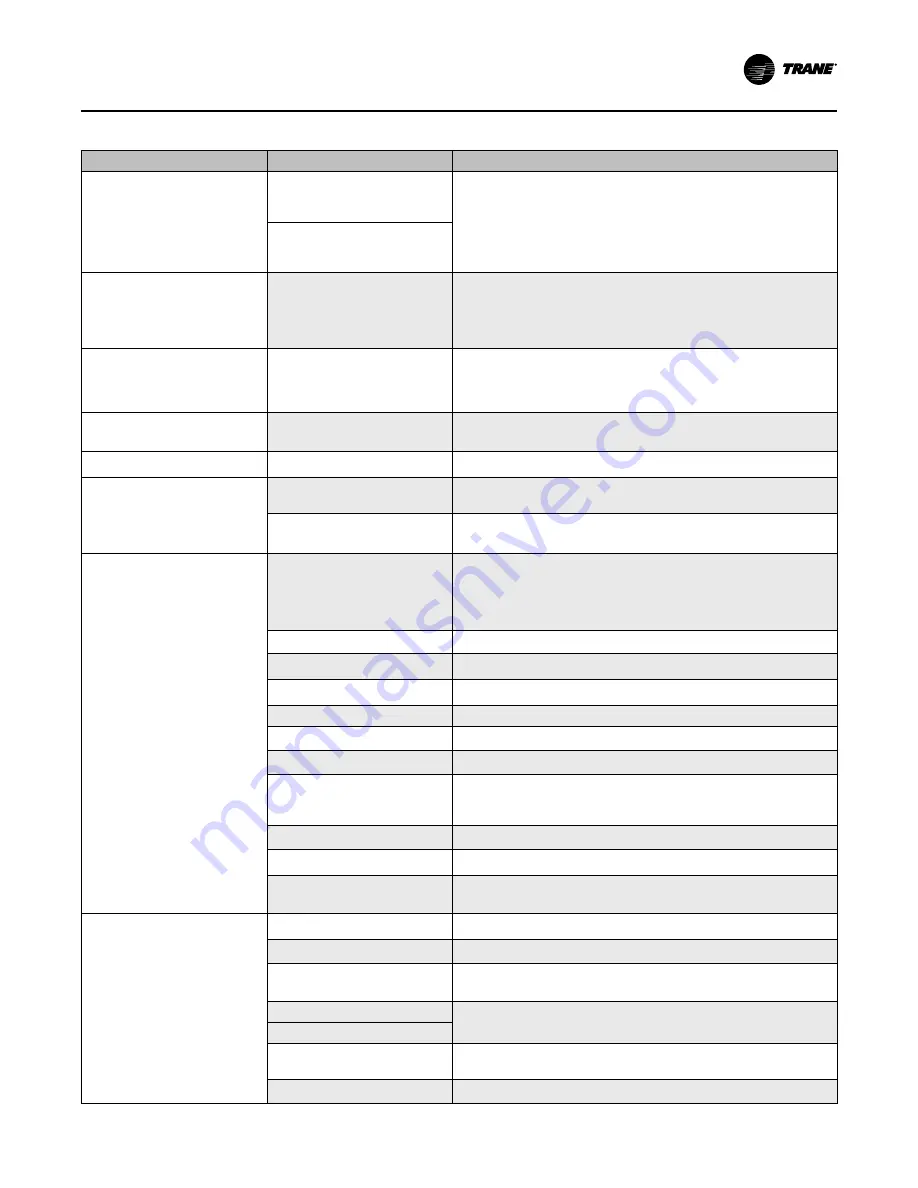
PRGD-SVX01F-EN
29
Table 2. Troubleshooting a purge system (continued)
Diagnostic or Problem
Cause
Solution
Carbon Regeneration Temperature
Limit Exceeded (latching
diagnostic)
The carbon tank temperature
exceeded 120% of the
regeneration temperature
setpoint.
Check carbon tank heater relay and heater wiring. Check the carbon tank
temperature sensor and its wiring.
Check the purge unit controls and settings.
The carbon tank temperature did
not decrease more than 25°F
(-3.9°C) in the first hour after the
heater is turned off.
Purge Daily Pump-out Limit
Exceeded (latching diagnostic)
The pump-out time recorded over
the past 24 hours has exceeded
the daily pump-out limit setpoint.
Air infiltration rate into chiller may be too high, leak check chiller and
repair leaks. The daily pump-out limit setpoint may be set too low. Check
and adjust to proper value. The chiller refrigerant temperature may be
too low. Do not operate purge at condensing temps of 40°F (4.4°C) or
lower. High vacuum pump-outs may be operated down to 32°F (0.0°C).
Set pump-out inhibit to
Enable
and set appropriate limit.
Comm Loss: xxxx (latching
diagnostic)
A loss of communication of more
than 30 continuous seconds has
occurred between the controller
and the identified component
(LLID).
Check the LLID and the interconnecting Machine bus. Check the LLID
configuration and function using the Tracer TU service tool.
Purge unit does not run or pump-
out system does not run.
Control circuit problem.
Run diagnostics of purge control system. Refer to the control circuit test.
Check the purge control for active diagnostics. Check the purge control
system using the Tracer TU service tool.
Purge continues to operate when
chiller is Off.
Purge is set to On or to Adaptive
operating mode.
Check operating mode. The On mode should be used only for specific
service procedures; Adaptive is the normal operating mode.
Pump-out compressor operates
continuously.
Purge refrigerant compressor
suction temperature is greater
than the pump-out initiate
setpoint.
Purge refrigerant compressor
suction temperature sensor has
failed.
Check sensor, LLID, and machine bus.
The control system has failed.
Check the controller by using diagnostic tools.
Purge fails to pump-out non-
condensables. Chiller observations
indicate air is actually present in
the chiller; that is, measured
condenser pressure is greater
than measured condenser
temperature converted to
pressure, and/ or chiller surges at
start-up.
Depending on the chiller type and
the operating conditions, air may
accumulate in the chiller
condenser away from the purge
vapor pick-up location (retrofit
purge).
Operate the purge with the chiller Off. Any air in the chiller will be
removed if the purge is functioning correctly. If a large amount of air is
removed, leak test the chiller and repair leaks. Consider using the
Adaptive mode to run the purge as required when the chiller is Off. If
non-condensable removal is required during chiller operation, relocate
the vapor/liquid connections to a more effective location.
Pump-out restrictor plugged.
Clean out restrictor orifice with compressed air (preferred) or a small
wire.
Purge condensing unit is
overcharged or undercharged.
Refer to the
“Determining the Refrigerant Charge Level,” p. 30
to
evaluate the purge charge level.
Purge expansion valve has failed.
Refer to the
“Determining Proper Expansion Valve Operation,” p. 31
to
evaluate the purge expansion valve performance.
Pump-out circuit fault.
Run diagnostic of purge control circuit. Refer to control circuit test.
Purge condensing unit fan has
failed.
Test and replace fan as needed.
Purge condensing unit condenser
coil is fouled.
Clean condenser coil as required.
Condensing unit compressor
motor winding temperature sensor
opened (line break thermostat).
Check condensing fan and coil. Check purge condensing unit charge
level. Check purge condensing unit compressor.
Check purge power supply. Replace line break protector if needed.
Replace compressor if needed.
Pump-out compressor fault—does
not run
Low voltage, no voltage, failed pump motor, failed controls.
Pump-out compressor fault—
pump motor runs
Failed pump diaphragm, failed pump reed valves, fitting leaks, line
restrictions, high-pressure drop across the pump.
Purge refrigerant compressor
suction temperature sensor
Not installed correctly or the thermal conductive paste has degraded.
Correct orientation of installed sensor and install thermal conductive
paste.
Pump-out compressor operates
continuously.
Purge refrigerant compressor
suction temperature is less than
the pump-out initiate value.
Purge is set to Auto mode and the
chiller run signal has failed.
Check the chiller run signal (retrofit purge). Check the controller system.
Excessive air in chiller.
Trace air source and repair any leak paths. Allow purge to remove
accumulated air.
Leakage in purge or purge pump-
out tubing.
Check all connections on purge and between the purge tank and the
pump-out compressor. Check all solenoid and other valves for possible
leakage.
Failed or restricted solenoid.
Failure of the pump-out solenoid to open, or a failure of the exhaust
solenoid to open. Check for dirt or contamination, failed or misaligned
armature, or an incorrect control command from the controller.
Pump-out restrictor plugged.
Gas pick-up connection of the
purge is below the liquid level of
the condenser.
Refer to the installation instructions of a retrofit purge. Check overall unit
operation.
Gas pick-up or return line
restricted.
Ensure shut-off valves are fully open and remove any restrictions.
T
Trro
ou
ub
blle
essh
ho
oo
ottiin
ng
g
Summary of Contents for PRGD series
Page 35: ...PRGD SVX01F EN 35 S Sc ch he em ma at ti ic c W Wi ir ri in ng g D Di ia ag gr ra am m ...
Page 36: ...36 PRGD SVX01F EN S Sc ch he em ma at ti ic c W Wi ir ri in ng g D Di ia ag gr ra am m ...
Page 37: ...PRGD SVX01F EN 37 N No ot te es s ...
Page 38: ...38 PRGD SVX01F EN N No ot te es s ...












































